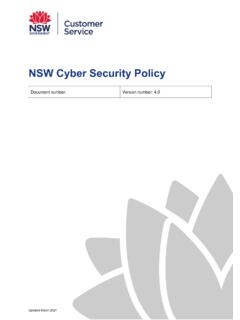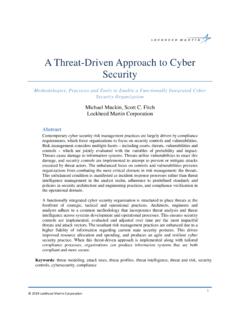Transcription of Guide to Enterprise Patch Management Technologies
1 Date updated: April 6, 2022 Withdrawn NIST Technical Series Publication Warning Notice The attached publication has been withdrawn (archived), and is provided solely for historical purposes. It may have been superseded by another publication (indicated below). Withdrawn Publication Series/Number NIST Special Publication 800-40 Rev. 3 Title Guide to Enterprise Patch Management Technologies Publication Date(s) July 2013 Withdrawal Date April 6, 2022 Withdrawal Note SP 800-40 Rev. 3 is superseded in its entirety by the publication of SP 800-40 Rev. 4. Superseding Publication(s) (if applicable) The attached publication has been superseded by the following publication(s): Series/Number NIST Special Publication 800-40 Rev.
2 4 Title Guide to Enterprise Patch Management Planning: Preventive Maintenance for Technology Author(s) Murugiah Souppaya; Karen Scarfone Publication Date(s) April 2022 URL/DOI Additional information (if applicable) Contact Computer security Division ( information Technology Laboratory) Latest revision of the attached publication Related information Withdrawal Announcement Link NIST Special Publication 800-40 Revision 3 Guide to Enterprise Patch Management Technologies Murugiah Souppaya Karen Scarfone C O M P U T E R S E C U R I T Y NIST Special Publication 800-40 Revision 3 Guide to Enterprise Patch Management Technologies Murugiah Souppaya Computer security Division information Technology Laboratory Karen Scarfone Scarfone Cybersecurity Clifton, VA July 2013 Department of Commerce Penny Pritzker.
3 Secretary National Institute of Standards and Technology Patrick D. Gallagher, Under Secretary of Commerce for Standards and Technology and Director ii Authority This publication has been developed by NIST to further its statutory responsibilities under the Federal information security Management Act (FISMA), Public Law ( ) 107-347. NIST is responsible for developing information security standards and guidelines, including minimum requirements for Federal information systems, but such standards and guidelines shall not apply to national security systems without the express approval of appropriate Federal officials exercising policy authority over such systems.
4 This guideline is consistent with the requirements of the Office of Management and Budget (OMB) Circular A-130, Section 8b(3), Securing Agency information Systems, as analyzed in Circular A-130, Appendix IV: Analysis of Key Sections. Supplemental information is provided in Circular A-130, Appendix III, security of Federal Automated information Resources. Nothing in this publication should be taken to contradict the standards and guidelines made mandatory and binding on Federal agencies by the Secretary of Commerce under statutory authority. Nor should these guidelines be interpreted as altering or superseding the existing authorities of the Secretary of Commerce, Director of the OMB, or any other Federal official.
5 This publication may be used by nongovernmental organizations on a voluntary basis and is not subject to copyright in the United States. Attribution would, however, be appreciated by NIST. National Institute of Standards and Technology Special Publication 800-40 Revision 3 Natl. Inst. Stand. Technol. Spec. Publ. 800-40 Rev. 3, 26 pages (July 2013) CODEN: NSPUE2 Comments on this publication may be submitted to: National Institute of Standards and Technology Attn: Computer security Division, information Technology Laboratory 100 Bureau Drive (Mail Stop 8930) Gaithersburg, MD 20899-8930 Certain commercial entities, equipment, or materials may be identified in this document in order to describe an experimental procedure or concept adequately.
6 Such identification is not intended to imply recommendation or endorsement by NIST, nor is it intended to imply that the entities, materials, or equipment are necessarily the best available for the purpose. There may be references in this publication to other publications currently under development by NIST in accordance with its assigned statutory responsibilities. The information in this publication, including concepts and methodologies, may be used by Federal agencies even before the completion of such companion publications. Thus, until each publication is completed, current requirements, guidelines, and procedures, where they exist, remain operative. For planning and transition purposes, Federal agencies may wish to closely follow the development of these new publications by NIST.
7 Organizations are encouraged to review all draft publications during public comment periods and provide feedback to NIST. All NIST Computer security Division publications, other than the ones noted above, are available at iii Reports on Computer Systems Technology The information Technology Laboratory (ITL) at the National Institute of Standards and Technology (NIST) promotes the economy and public welfare by providing technical leadership for the Nation s measurement and standards infrastructure. ITL develops tests, test methods, reference data, proof of concept implementations, and technical analyses to advance the development and productive use of information technology.
8 ITL s responsibilities include the development of Management , administrative, technical, and physical standards and guidelines for the cost-effective security and privacy of other than national security -related information in Federal information systems. The Special Publication 800-series reports on ITL s research, guidelines, and outreach efforts in information system security , and its collaborative activities with industry, government, and academic organizations. Abstract Patch Management is the process for identifying, acquiring, installing, and verifying patches for products and systems. Patches correct security and functionality problems in software and firmware.
9 There are several challenges that complicate Patch Management . If organizations do not overcome these challenges, they will be unable to Patch systems effectively and efficiently, leading to easily preventable compromises. This publication is designed to assist organizations in understanding the basics of Enterprise Patch Management Technologies . It explains the importance of Patch Management and examines the challenges inherent in performing Patch Management . This publication also provides an overview of Enterprise Patch Management Technologies and briefly discusses metrics for measuring the Technologies effectiveness and for comparing the relative importance of patches.
10 Keywords information security ; Patch Management ; remediation; software patches; vulnerability Management iv Acknowledgments The authors, Murugiah Souppaya of the National Institute of Standards and Technology (NIST) and Karen Scarfone of Scarfone Cybersecurity, wish to thank their colleagues who reviewed drafts of this document and contributed to its technical content, particularly Peter Mell of NIST. Acknowledgments, Version 2 The authors, Peter Mell of NIST, Tiffany Bergeron of The MITRE Corporation, and David Henning of Hughes Network Systems, LLC, wish to express their thanks to Rob Pate of the United States Computer Emergency Readiness Team (US-CERT) for providing support for this publication.














